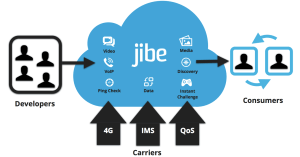Jibe Mobile has closed an $8.3 million funding round from investors including Vodafone Ventures, the VC arm of the telco, and Japanese mobile content provider MTI, plus other unnamed investors.
You may recall Jibe from 2008 — when it was offering a mobile app for sharing content on social networking sites. Since then the company has changed shape — morphing from app maker to platform creator. It’s also been working with carriers to build out IP-based network interconnectedness (aka the Joyn initiative). Right now, Jibe describes itself as a cloud-based global communications provider. Or at least, that’s its ambition — and that grand plan is where the new funding comes in.
Today’s funding announcement is Jibe’s only external funding to-date (not counting an $800,000 angel investment in its earlier business). In recent years the company had been producing revenues so did not need to seek other funds, the CEO tells me. But its new business has an extremely ambitious scope — firm emphasis on the words ‘global’ and ‘cloud’ here — so the financial resources required to both get it up and running and ensure it can scale as demand grows are an order of magnitude greater than its earlier app effort.
A Platform For Apps To Call Each Other
In a nutshell Jibe is building a cloud platform for app developers to more easily (and cheaply) incorporate rich, real-time comms/connected features into their apps — such as VoIP calls, video chatting and over-the-top multiplayer social gaming features. Using its SDK and APIs, Jibe says developers can add a Skype-style video calling feature to their app in a matter of minutes, for instance, by dropping in a few lines of code. 
“In the case of video for example, with four lines of Android code they can make video work inside their app,” says CEO Amir Sarhangi. “They don’t have to know anything about SIP, IMS, any of the technologies that’s used in doing for example video chat – codecs – they don’t need to know any of that.
“As far as the infrastructure’s concerned, they’re leveraging our infrastructure – we have datacenters in multiple locations in the world and then we have proxy servers stationed in many, many different parts to make the experience really good.”
As well as having lots of datacenters to shuttle all the bits and bytes around — Jibe has offices in Mountain View, London, Düsseldorf and Tokyo — it is working with carriers to optimise its platform for their individual networks. “Underneath it all, wherever we have relationships with mobile carriers we can deliver a better experience so as an example if you happen to be a Vodafone user you’re just going to get an even better experience because we are tied into their network.
“But nothing is dependent on carriers so from a developer and a consumer perspective it works everywhere,” he adds. “As we turn on additional carrier relationships, our network gets better and the quality we can deliver gets better.”
“What we see is a vision of the future where all applications are connected — and by that we mean applications that essentially have things like video chat inside of them, VoIP, the ability to do things like multiplayer gaming with each other – so you’ve got two apps where you can play a game over the mobile network. Something that traditionally has been very very difficult for app developers to do just because of the nature of mobile networks and the complication of being able to deliver on various mobile platforms.”
From One App To Another
If you’re still scratching your head at the “cloud-based global communications provider” moniker, here’s a video demonstrating one use-case of Jibe’s platform — showing how an Air Hockey game app is able to incorporate a social gaming multiplayer mode, that allows the user to identify which of their contacts has the app and also has connectivity to play at that particular moment and then send a ‘gaming challenge’ to ask their buddy to play. (“It’s almost like two applications calling each other” is how Sarhangi describes it.)
Jibe’s cloud platform does the real-time data transfer that links the two apps so the two players can play against each other from their respective phones and locations — with low enough latency levels to ensure decent gameplay. The best performance is on 4G networks (40 to 60ms latency in that instance), but Sarhangi says Jibe’s platform also works on HSPA and 3G networks — although some types of very time-sensitive games may suffer a bit of a performance knock at those slower network speeds.
Another feature of the platform is the ability to support multitasking real-time applications — so a video call window can be popped out so that other phone features can be accessed by the user while they carry on chatting, for example. The platform isn’t just for game developers either — Sarhangi flags up an e-learning use-case where a developer incorporated a digital white board into the mix to share video from a mobile e-learning app to a classroom screen. Many types of app developers could benefit from catching a ride on Jibe’s cloud, he says.
Jibe Before The Pivot: Joyn-ing Forces
This latest Jibe pivot grew out of work it did for Vodafone to help build Joyn — a carrier initiative aimed at ensuring interoperability of IP services (such as IM and picture messaging) across different networks and geographies. Joyn does this through the use of a new, single communications standard — but has yet to get more than a handful of carriers signed up so it remains a work in progress.
One part of Jibe’s business is to act as a stop-gap for Joyn — to make good on the technology’s interoperability promise before mass carrier adoption achieves the same end (this part of its business is called JoynNet). But while working on Joyn, Sarhangi says Jibe also realised there was space to build a new business that sits between developers and carriers — to help the two groups help each other.
“We had a lot to do with Joyn to begin with and one of the main passions we have as a company is the fact that in helping create Joyn we realised that it’s extremely difficult for developers to do this stuff,” says Sarhangi. “So how do we make it really simple and, on the other hand, having been with carriers and worked with carriers it is difficult to work with carriers as a small developer, because they’re such a big company, so how do you make that also simple so that you bring the two sides together and break the barriers down.”
 Future features and fees
Future features and fees
In future, as the Jibe cloud platform develops, Sarhangi envisages being able to support four-way video calls, or modify voice or video calls with an overlay. “What you see now is the base, the foundation,” he says, adding that the company intends to be led by its developer community to incorporate the features they request. “When the developers themselves are successful that makes us successful so, for us, it’s not a race for as many features in the world, it’s a race to make them successful.”
Jibe’s platform, which includes support for Joyn so it’s ‘futureproofed’ for carrier network evolution, currently supports Android apps but the company is working on iOS support (Sarhangi says it will “probably” be making an announcement on iOS availability in early Q1). It is also planning a WebRTC version.
The platform recently came out of private beta — and has more than 500 developers signed up. While it’s currently free for developers to use, Jibe’s business model involves charging developers in future — although it says it will only charge “once they are successful” – i.e. once their app has exceeded a certain number of concurrent video calls or voice calls made through Jibe’s platform.
The funding round announced today will be used for “product side” work — such as completing iOS support. It will also be used to scale the platform to cope with increased demand. “Clearly we’re running a global cloud so we need a team to make sure that we can support a truly [global] experience,” says Sarhangi. “We need to be able to deliver [low latency performance] everywhere. And, as we have more of the demand it is pretty resource intensive to work with developers and carriers – two groups that are somewhat fragmented and require a lot of attention.”
The Carriers’ Cut: A Gamer-Proof Tariff?
So what’s in it for the carriers to work with Jibe? The chance to “re-innovate around their core services in an all-IP world” — and a world of flat/declining voice and text revenues, says Sarhangi. Jibe’s platform should end up driving data revenues for carriers but more importantly it’s offering them the chance to investigate new business models fit for an age of over-the-top, all-IP services.
“Traditionally carriers haven’t been very good at doing something for the sake of it, and getting everybody excited about it and then figuring out how to generate the revenues. They’ve always been very financially driven. I worked for Vodafone for almost seven years running products and services for Vodafone Japan and we never did anything unless it was fully fully thought out and financially feasible,” says Sarhangi.
“I think now they’re taking a different approach a little bit – they’re trying to take a page out of the internet book of how you do services and this scenario is not just about driving data revenue, it’s about in the future can there be a day where we can sell a plan where game developers can have this ultra high speed experience guaranteed to them for a fee?
“So it’s about segmenting their packaging and making their networks a lot more smart about how it’s packaged for both developers but also at the end consumers. I’ll pay the extra $5 if you can guarantee me that I’m always going to have a really awesome experience with my friends, playing these multiplayer games.”
